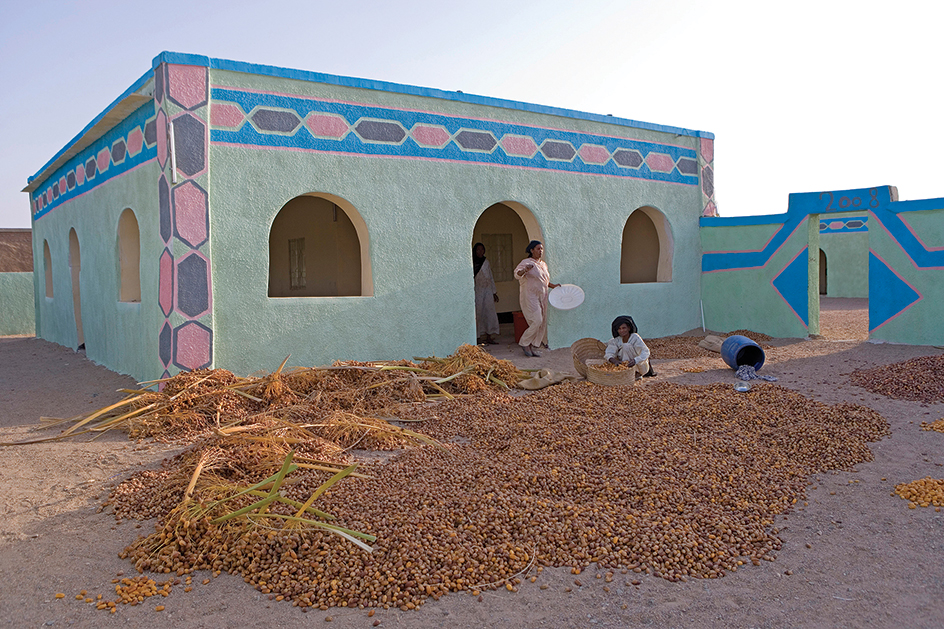Date palm is an important fruit tree of the Middle East. Date palms are cultivated for their fruit, called dates. The trees thrive in hot, dry climates. They grow throughout northern Africa and the Middle East, and they flourish in desert oases where few plants can grow. The date palm is one of the oldest crop plants. Early civilizations began to cultivate date palms at least 5,000 years ago. Today, dates still form an important part of the diet in many desert countries.
Uses.
Date palms have many uses. They provide nourishment, shade, building materials, and fuel. They are especially important to Muslim peoples of the Middle East. According to Muslim tradition, the date palm represents the tree of life.

Dates have a high sugar content, making them rich in carbohydrates. People eat dates fresh or dried. Dried dates can be used in cooking and are easily stored and preserved. Sugar obtained from the sap of the tree and juice pressed from dates serve as sweeteners. People ferment date mash into an alcoholic drink called arak, also spelled arrack.
People use the trunk and leaves as building materials. They weave the leaves into baskets, mats, and other articles. Fiber from the bark makes strong rope. Even the pits are burned as fuel or are used as animal feed when ground up.
The tree.
Date palms grow as tall as 100 feet (30 meters). They have a straight, rough trunk of about the same thickness from base to top. Featherlike leaves from 10 to 20 feet (3 to 6 meters) long fan out from the top of the trunk. Growths called suckers sprout near the base of the trunk and may develop into new plants. For this reason, date palms tend to grow in clumps.
Flowers typically bloom on the trees between February and June, and the fruit usually ripens from June to December. Male and female flowers grow on separate trees. Male flowers produce pollen, and female flowers develop into fruit.
The date
is an oblong fruit that measures 1 to 2 inches (2.5 to 5 centimeters) in length. Thick, sweet flesh, covered by tough skin, surrounds a single large seed. Dates range in color from yellow to orange, red, or green, depending on the variety.
Dates grow in clusters at the end of stalks. A single cluster on some mature varieties of date palm can hold between 600 and 1,700 dates at time of picking. Date palms bear much fruit. They commonly produce at least 100 pounds (45 kilograms) of fruit annually for about 60 years.

Cultivation and production.
Dates require warm temperatures and low humidity to ripen properly. The roots of the date palm need a regular supply of water, such as that provided by irrigation or an underground spring. Date palms may be raised from seeds. But growers more commonly raise them from suckers cut from a parent plant. Growers plant the suckers in rows about 30 feet (9 meters) apart. Trees begin to flower and bear fruit about four years after planting.
Pollen influences the size, shape, and ripening time of the fruit. Pollination can occur naturally by means of wind. But growers usually pollinate trees by tying a male flower cluster to a female cluster. Paper bags placed above the ripening fruit help prevent damage from rain. Netting or porous cloth placed over the clusters protect the fruit from insects and birds.

Workers harvest the clusters of dates by hand. They then put the dates in a warm place to ripen further and dry. This additional ripening increases the sugar content and reduces acidity.
Growers produce about 10 million tons (9 million metric tons) of fresh dates annually. Egypt, Iran, and Saudi Arabia are the largest producers of dates. Other important producers include Algeria, Iraq, Pakistan, South Sudan, and Sudan. In the United States, cultivation occurs primarily in the desert valleys of Arizona and California.
